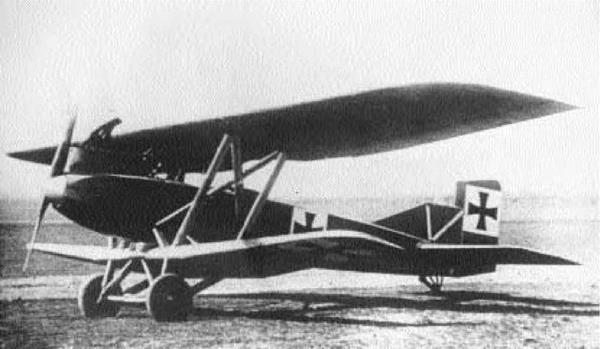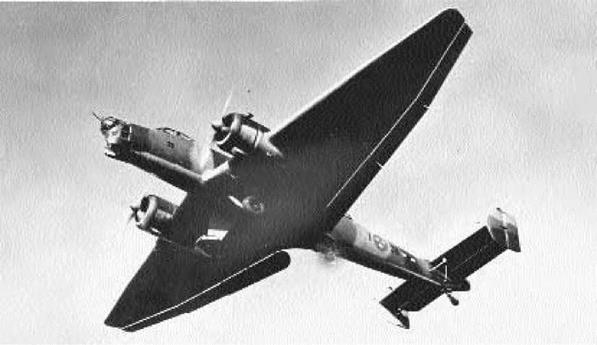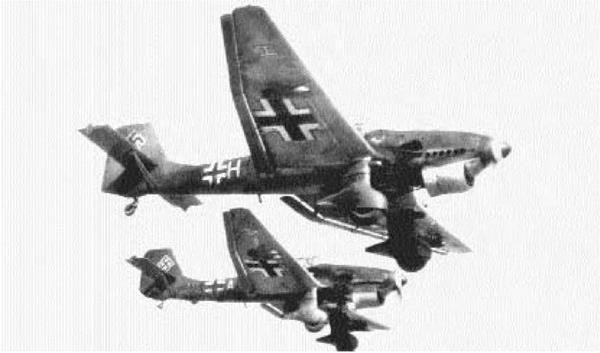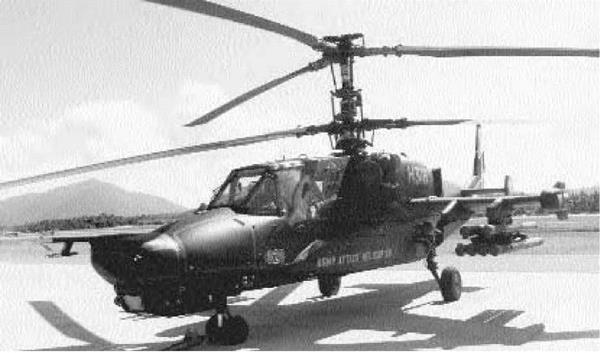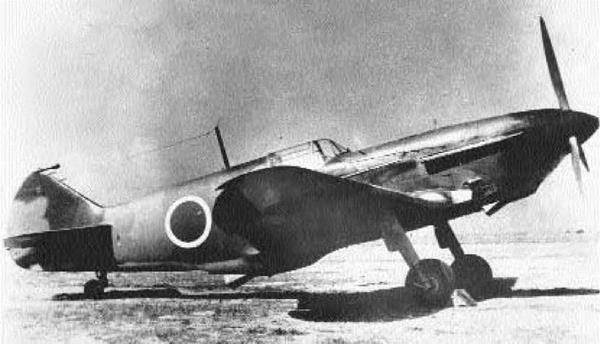. IAI Kfir Israel
Dimensions: wingspan, 26 feet, 11 inches; length, 54 feet; height, 13 feet, 11 inches
Weights: empty, 16,06 pounds; gross, 36,376 pounds
Power plant: 1 18,750-pound thrust General Electric J-79 turbojet engine
Performance: maximum speed, 1,516 miles per hour; ceiling, 58,000 feet; range, 548 miles
Armament: 2 x 30mm cannons; up to 13,415 pounds of bombs or rockets
Service dates: 1975-
|
T |
he Kfir resulted from Israel’s attempt to sever its traditional dependency upon France for military aircraft. It was a feat of considerable engineering and placed that country in the forefront of aviation technology.
Since acquiring independence in 1947, the state of Israel relied heavily upon French patronage for modern weapons to defend itself against its Arab neighbors. In the early 1960s Israel acquired the relatively sophisticated Dassault Mirage IIIs, which were superbly utilized in the 1967 Six Day War. Israel had also ordered 50 of the less-expensive Mirage 5 ground-attack craft, fully paid for, when French President Charles de Gaulle ordered an arms embargo. Cut off from its main supplier of aircraft, and faced with the specter of the Soviets arming Arab states with sophisticated MiG fighters, the Jewish state resolved to develop indigenous fighters. This required imaginative engineering of a very high order.
Israeli Aircraft Industries (IAI) initially began by marketing its own version of the Mirage 5, which
it called the Nesher (Eagle). This was a potent craft but possessed all the shortcomings of the original Mirage III design. But having purchased McDon- nell-Douglas F-4 Phantoms from the United States, the firm hit upon squeezing the powerful J-79 turbojet engine into the Mirage 5 fuselage. This feat required engineering skills and was resolved only after much difficulty. However, the resulting new craft, the Kfir (Lion Cub), was revealed to the world in 1975. This was still a Mirage in outline, but it possessed an expanded fuselage to accommodate the bigger engine. The rear was also consequently shortened and the front extended in comparison with the Mirage 5. And because the J-79 runs hotter than the original French power plant, four additional airscoops were installed. Newer versions of the Kfir, the C2, feature removable canards just aft of the canopy to improve maneuverability at low speed. The Kfir remains a potent weapon in Israeli hands and has also been exported to Colombia and Ecuador.
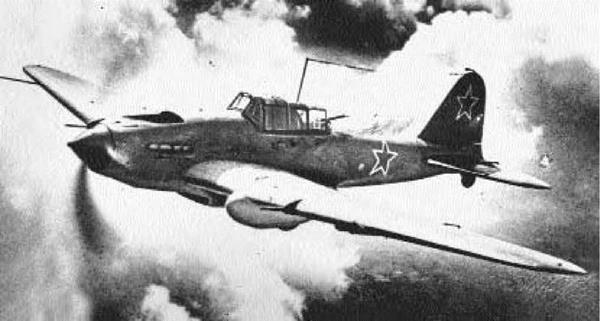
Type: Antitank; Light Bomber
Dimensions: wingspan, 48 feet; length, 36 feet; height, 11 feet, 1 inch Weights: empty, 9,590 pound; gross, 14,021
Power plant: 1 x 1,770-horsepower AM-38F liquid-cooled in-line engine Performance: maximum speed, 251 miles per hour; ceiling, 19,685 feet; range, 373 miles Armament: 2 x 7.62mm machine guns; 2 x 30mm cannons; 1,321 pounds of bombs or rockets Service dates: 1941-1955
|
T |
he famous Shturmovik was the most important Russian aircraft of World War II. Built in massive quantities, it proved instrumental in defeating German armor and preserving the Soviet Union. The Il 2 is also among the most numerous warplanes ever built.
The Red Air Force was conceived as a tactical adjunct to the Red Army and, as such, bore responsibility for removing tanks and fortifications in its path. Throughout the 1930s several experimental craft were tested that were heavily armored and intended to function as bronirovanni shturmovik (armored attackers). In 1939 Sergei Ilyushin developed a prototype that was to exert profound influence on the military history of the world. His Il 2 was a relatively sleek, all-metal, low-wing monoplane with retractable undercarriage that withdrew into wing nacelles. The most distinguishing feature was the highly armored “tub,” an integral metal structure holding the engine, pilot, and fuel. It was impervious to ground fire and gave the aircraft great structural integrity. Test flights were encouraging, so the first
Il 2s became operational in May 1941. Their appearance was fortuitous, for the following month Nazi Germany invaded the Soviet Union.
From the onset, the Il 2 proved itself the bane of German tanks. Flying low at treetop level, it swooped upon them from behind, where their defenses were weakest, delivering lethal blows. Many Il 2s were lost for want of a tailgunner, so in 1942 a two-seat version was introduced with even heavier weapons, including the world’s first air-to-ground rockets. These performed essential work during the 1943 battle at Kursk, knocking out many of Germany’s latest Tiger tanks with ease. The Il 2 was so important that Stalin himself declared it “as essential to the Red Army as bread and water”—and warned factory officials to produce them faster. With some justification, Germans regarded the Il 2 as the Schwartz Tod (Black Death). This landmark Russian design remained in production until 1955 after 36,000 had been built. Only the vaunted Po – likarpov Po 2 was obtained in greater quantity.
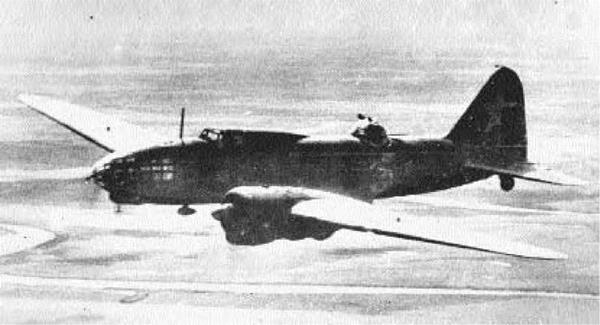
Type: Medium Bomber; Torpedo-Bomber
Dimensions: wingspan, 70 feet, 4 inches; length, 48 feet, 6 inches; height, 13 feet, 5 inches Weights: empty, 13,228 pounds; gross, 22,046 pounds Power plant: 2 x 1,100-horsepower M-88B radial engines
Performance: maximum speed, 255 miles per hour; ceiling, 32,810 feet; range, 1,616 miles Armament: 3 x 12.7mm machine guns; up to 2,205 pounds of bombs or torpedoes Service dates: 1937-1945
|
T |
he Il 4 was another simple, exceedingly tough design that saw widespread use during World War II. It gained notoriety for becoming the first Soviet bomber to raid Berlin in 1941.
In 1936 Sergei Ilyushin delighted Soviet authorities by designing the DB 3 medium bomber. This was an all-metal, low-wing, twin-engine craft with a peculiarly blunt nose turret. More important, the craft boasted outstanding performance for its day and established several payload and altitude records. DB 3s became operational in 1937, and the following year Ilyushin began developing an improved variant, the DB 3F. This plane differed from its pug-nosed predecessor by sporting a redesigned, streamlined nose that was highly glazed. Other refinements included greater internal capacity for fuel—in this instance up to 27 percent of its loaded weight—and an autopilot. The DB 3F consequently enjoyed excellent long-range capability for a relatively small bomber. In addition to carrying a useful payload, it could also be fitted with a torpedo for an
tishipping work. DB 3Fs became operational in 1939 with both Red Air Force and Red Navy bomber regiments. The following year it was redesignated Il 4 after the new Soviet system of employing designers’ initials. Ultimately, 5,520 were constructed.
Il 4s were the most numerous bomber in the Soviet inventory when Nazi Germany invaded Russia in June 1941. They gained international notoriety on the evening of August 8, 1941, when several navy Il 4s staged the first Russian bombing raid on Berlin. German advances, meanwhile, forced Ilyushin to relocate his factories beyond the Ural Mountains. There he faced critical shortages of strategic metals, and so many Il 4s were partially constructed of wood. This did not detract from the basic robustness of the design, although Il 4s continually suffered from weak defensive armament. This unsung aircraft, largely unknown to the West, fought hard, absorbed staggering losses, and performed well up through the end of the war. It remains an unsung hero of the Soviet Union.
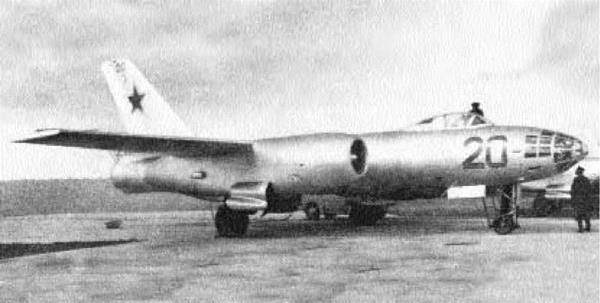
Type: Light Bomber
Dimensions: wingspan, 70 feet, 4 inches; length, 57 feet, 11 inches; height, 22 feet
Weights: empty, 26,455 pounds; gross, 46,300 pounds
Power plant: 2 x 6,040-pound thrust Klimov VK-1 turbojet engines
Performance: maximum speed, 560 miles per hour; ceiling, 40,350 feet; range, 684 miles
Armament: 4 x 23mm cannons; up to 2,205 pounds of bombs
Service dates: 1950-
|
T |
he Il 28 was the first Soviet jet bomber and a direct counterpart of the North American B-45 Tornado and British Canberra. Less capable than either, it nonetheless enjoyed a service career of great longevity and still flies in China.
After World War II a race commenced to evaluate captured German jet technology and incorporate it into new generations of warplanes. For the Soviet Union, this meant development of a practical jet bomber that would eventually carry atomic weapons. The Ilyushin design bureau constructed the Il 28 prototype in 1948 as a high-wing, twin-jet design with swept tail surfaces. Curiously, the main wing was straight with a tapered trailing edge. A crew of three was housed in a streamlined, attractive fuselage. The bombardier sat in a glazed nose section while the pilot was sequestered under a handsome canopy, and the tailgunner reposed in a turret reminiscent of the Boeing B-29, from which it had been copied. The Il 28 was powered by two VK – 1 engines, mounted far forward beneath the wings.
The craft was originally flown with weak Junkers Jumo engines, but due to the shortsightedness of the British Labor government, the Soviets obtained examples of the latest Rolls-Royce Nene—then the world’s finest. The prototype flew well on these copied engines, and the design entered production in 1949. However, Stalin insisted that at least 25 Il 28s be utilized in the 1950 May Day flyover, and the company strained every resource to successfully meet his demand. At length 6,317 Il 28s were constructed and received the NATO designation BEAGLE.
The Il 28 enjoyed a long service record with Russian and numerous Warsaw Pact air forces. The type was also widely exported abroad to several communist client states. Il 28s were primitive machines and carried a relatively light payload, but they displayed rugged construction and ease of maintenance. Russian and Eastern European Il 28s have long been retired, but China retains and operates a number as trainers.
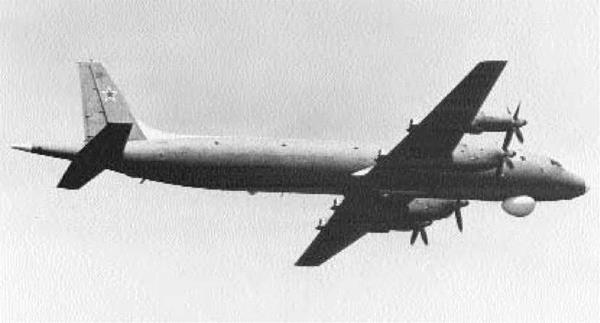
Type: Antisubmarine; Reconnaissance
Dimensions: wingspan, 122 feet, 9 inches; length, 129 feet, 10 inches; ceiling, 33 feet, 4 inches
Weights: empty, 79,365 pounds; gross, 139,991 pounds
Power plant: 4 x 4,250-horsepower ZMD AI-20 turboprop engines
Performance: maximum speed, 448 miles per hour; ceiling, 32,810 feet; range, 2,299 miles Armament: unknown Service dates: 1967-
|
T |
he far-ranging Il 38 was the Soviet Union’s first long-range antisubmarine aircraft. It is also encountered while performing reconnaissance and electronic intelligence-gathering missions.
During World War II, the Allies acquired tremendous experience in the field of antisubmarine warfare (ASW) throughout the Atlantic and Pacific theaters. Afterward, they parleyed this expertise into several specifically designed ASW aircraft like Lockheed’s P2V Neptune. Russia, primarily a land power, felt no such necessity and was content to deploy short-range platforms like the Beriev Be 12 for coastal patrol work. However, the advent of missilefiring submarines in the 1960s interjected new urgency to the development of such aircraft. Because nuclear-tipped submarine-launched missiles constituted a vital threat to Russia, they had to be engaged far away from coastal waters to be defeated. It was not until 1967 that the Soviets fielded their first dedicated ASW aircraft, the Ilyushin Il 38, known by the NATO code name MAY. This was essentially a highly modified Il 18 commercial airliner adapted for long-
range maritime reconnaissance. The West had previously set a precedent by developing two similar craft, the Lockheed P-3 Orion and BAe Nimrod, also from civilian craft. The most notable difference from the II18 is the forward positioning of the wing, which suggests that the center of gravity has been altered by the presence of heavy equipment in the front fuselage. The Il 38 also displays a very prominent chin radome, along with the numerous protuberances and airducts typical of ASW designs.
Little is known of the capability or armament of the Il 38, but certainly it cannot be slighted. Two spacious bomb bays, before and after the wing, are undoubtedly crammed with a huge array of sonobuoys, depth charges, homing torpedoes, and other tools of the ASW trade. But its procurement in small numbers (around 60) suggests that the more numerous Tu 142 BEAR is actually the preferred machine for this role. The only other operator is India, which maintains its own five-plane squadron of Il 38s. Operationally, the craft appears slated for replacement soon.
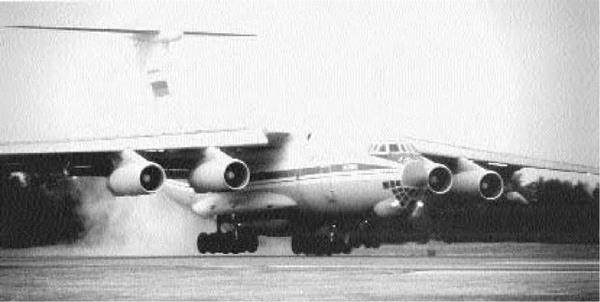
Type: Transport; Early Warning
Dimensions: wingspan, 165 feet, 8 inches; length, 152 feet, 10 inches; height, 48 feet, 5 inches
Weights: empty, 216,050 pounds; gross, 374,780 pounds
Power plant: 4 x 26,455-pound thrust Soloviev D-30KP turbojet engines
Performance: maximum speed, 528 miles per hour; ceiling, 50,855 feet; range, 3,107 miles
Armament: 2 x 23mm cannon
Service dates: 1974-
|
T |
he Il 76 is a standard Russian heavy air transport capable of carrying heavy loads to remote, unprepared landing strips throughout Siberia. Modern variants also serve as that nation’s most advanced airborne warning command center.
The advent of Lockheed’s C-141 Starlifter in 1965 demonstrated the viability of large jet transports. Its great range and lifting capacity certainly inspired the Soviet government to acquire a similar machine for its own use. Such a craft would be especially useful in helping to develop remote parts of Russia like Siberia, where adverse operating conditions are routine. The government then instructed the Antonov design bureau to create such a beast; of course, it had to be bigger and better than its capitalist counterpart. In 1971 Antonov complied with the prototype Il 76, which bore great similarity to the Starlifter. It possessed a high-mounted wing fitted with leading-edge slats and trailing-edge slotted flaps for quick takeoffs. The spacious fuselage was circular in cross-section with streamlined fairings on either
side to house the landing gear. As with most Soviet airplanes, the tire pressure can be adjusted in flight for landing on any kind of surface. The Il 76 became operational in 1974 and broke several altitude and payload records. Around 750 have been built, making it among the most numerous aircraft of its class in the world. The NATO designation is CANDID.
Around this time the United States began manufacturing self-guided cruise missiles, which are small, fast, and designed to operate at altitudes below a radar net. The Soviets responded by converting several Il 76s into airborne early warning and control (AWACS) aircraft. The AWACS version of the Il 76, called the A 50, is fitted with a rotating radome that scans downward and picks out missiles from the ground clutter. This information is then relayed by computer to MiG 31 interceptors, which then maneuver to engage the missiles. This version, built by Beriev, received the NATO designation MAINSTAY and will probably see frontline service for years to come.
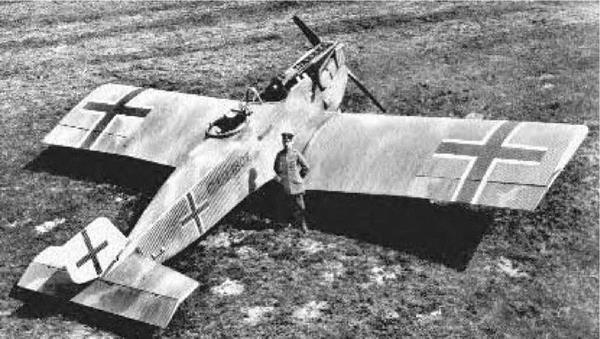
Type: Light Bomber
Dimensions: wingspan, 39 feet, 6 inches; length, 25 feet, 11 inches; height, 7 feet, 9 inches Weights: empty, 1,562 pounds; gross, 2,310 pounds
Power plant: 1 x 180-horsepower Mercedes D Ilia liquid-cooled in-line engine Performance: maximum speed, 100 miles per hour; ceiling, 19,685 feet; range, 200 miles Armament: 3 x 7.92mm machine guns Service dates: 1918-1919
|
T |
he angular, futuristic CL I was probably the best attack aircraft of World War I. It was certainly the most sophisticated of its day and pioneered building techniques that were years ahead of the time.
In the spring of 1918, the Junkers firm sought to replace the Halberstadt CL attack planes with a derivative of its ultramodern D I fighter. The new craft flew on May 4, 1918, and, like its predecessor, was built entirely of metal. It consisted of a steel – tube structure covered by corrugated metal skinning, buttressed by extensive internal bracing. This combination provided the craft with both strength and lightness. The fuselage employed a carlike radiator placed in front of the engine and just above the thrust line. A crew of two was also provided with separate cockpits. The gunner’s position, in particular, was elevated and granted an unimpeded field of fire. In the air, the CL I was speedy, agile, and virtually impervious to small-arms fire. These traits made
it ideal for low-level ground attacks, so CL Is were outfitted with bomb racks, hand grenades, and other antipersonnel devices. For strafing duties, the pilot also operated two fixed machine guns.
Production of the CL I commenced in the summer of 1918, and 47 machines arrived at the front before the war ended. They were certainly the most advanced attack craft deployed by either side, years ahead of competing designs. Although there is no record of CL Is being used on the Western Front, they most certainly operated against Bolshevik forces in Finland, Estonia, and Latvia throughout 1919. Flown by veteran German pilots, CL Is were credited with excellent results. An interesting derivation was the CLS, a floatplane created for reconnaissance duties. Three examples were delivered to the navy, but no orders were forthcoming. After the war, a single CL I was also fitted with a canopy over the rear seat, thus becoming the first-ever all-metal airliner.
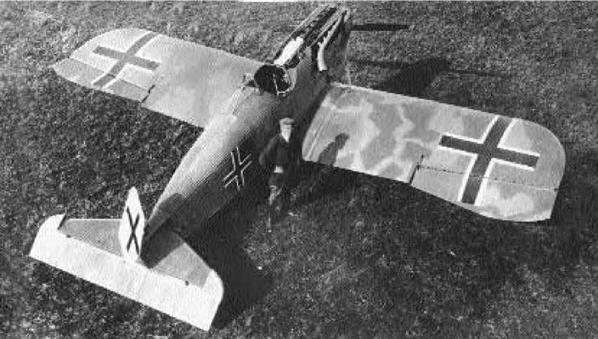
Type: Fighter
Dimensions: wingspan, 29 feet, 6 inches; length, 23 feet, 9 inches; height, 7 feet, 4 inches
Weights: empty, 1,439 pounds; gross, 1,835 pounds
Power plant: 1 x 185-horsepower BMW liquid-cooled in-line engine
Performance: maximum speed, 118 miles per hour; ceiling, 19,685 feet; range, 150 miles
Armament: 2 x 7.92mm machine guns
Service dates: 1918-1919
|
T |
he diminutive Junkers D I was the first all-metal fighter plane produced in quantity. Deployed but never tested in battle, it dramatically foreshadowed events to come.
Hugo Junkers had conceived and constructed the first all-metal aircraft as early as 1915. This was the J I, a compact monoplane with relatively high performance. However, the conservative-minded German military greeted such futuristic contraptions with suspicion and manifested no official interest. Junkers persisted with several intervening designs, and he arrived at the J 7 in October 1917. This was another monoplane aircraft, exceptional in being fitted with pivoting wingtips, instead of ailerons, for longitudinal control. When these were found to cause wing flutter, more conventional arrangements were affixed. However, one feature that could not be overlooked was the radiator, which bizarrely sat astride the engine, directly blocking the pilot’s view! Subsequent revisions relocated it toward the front of the fuselage. It was not
until March 1918 that Junkers fielded his most refined effort, the J 9. As before, this was a low-wing cantilever monoplane with considerable military promise. It flew effectively during the D-class fighter trails at Aldershof, and authorities finally decided to authorize production that spring.
The new craft entered the military service as the Junkers D I in the summer of 1918. It differed from the prototype in only minor details, but the most obvious was the large ailerons of unequal chord on each wing. A rollbar to protect the pilot in the event of an overturned landing was also fitted. The D I’s metal construction rendered it light and strong, and once airborne it was fast and agile. Junkers’s invention might have wielded considerable influence in the waning weeks of World War I, but because the construction techniques employed were so novel, only 41 machines were delivered before the Armistice that November. After the war, several were exported to the Baltic states and flown by German pilots against Bolshevik forces there.
|
Dimensions: wingspan, 52 feet, 5 inches; length, 29 feet, 10 inches; height, 11 feet, 1 inch
Weights: empty, 3,885 pounds; gross, 4,795 pounds
Power plant: 1 x 200-horsepower Benz BZ IV liquid-cooled in-line engine
Performance: maximum speed, 96 miles per hour; ceiling, 13,100 feet; range, 193 miles
Armament: 3 x 7.92mm machine guns
Service dates: 1918
|
T |
he big J I appeared so ungainly to crew members that it was unofficially known as the “Moving Van.” However, it was heavily armored and ideally configured for the dangerous work of ground support.
For many years Hugo Junkers proffered the idea of all-metal airplanes to a skeptical German High Command. Commencing in 1915, when he constructed the first metallic monoplane, Junkers developed a succession of viable designs that had obvious military applications. His perseverance paid off in 1917, when the government finally approached him to design and develop an armored biplane for the Infanterieflieger (ground-support units). The ensuing Junkers J I turned out to be one of the most unusual, if not outright ugly, aircraft employed by the German air arm during this conflict.
Despite a conventional biplane configuration, the JI was unique in several aspects. Its most prominent feature was the enormous top wing, spanning more than 50 feet tip to tip. It possessed a thick airfoil section and cantilevered construction and was
made entirely of metal frames with corrugated covering. The lower wing was of identical planform but nearly a third smaller. The intrinsic strength of these units meant that they were fastened to the fuselage only by a series of inboard struts. The J I’s fuselage, meanwhile, possessed an unusual octagonal crosssection. Its front half consisted of a completely armored “tub” that housed the motor, fuel, pilot, and gunner. To the rear were large, almost rectangular tail surfaces, also covered in metal. In service the J I was heavy to fly, required a long runway for takeoff, and was difficult to land on short strips. It was so ungainly in bulk that crew members christened it the Mobelwagen (Moving Van).
Despite appearances, Junkers’s design was superbly adapted for infantry close-support missions. Its heavy armor made it nearly invulnerable to small – arms fire from below, and it also exhibited good low – altitude characteristics. No less than 227 of these rugged craft were built, and they served with distinction along the Western Front throughout 1918.
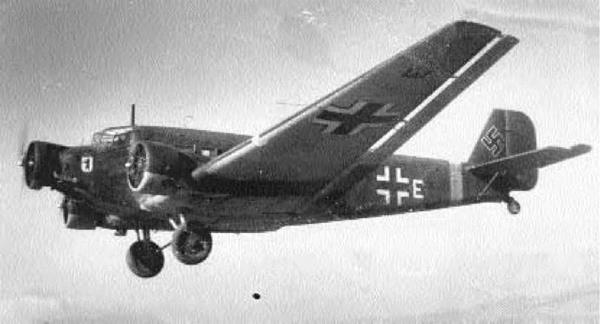
Type: Transport
Dimensions: wingspan, 95 feet, 11 inches; length, 62 feet; height, 18 feet, 2 inches
Weights: empty, 12,610 pounds; gross, 23,149 pounds
Power plant: 3 x 725-horsepower BMW 132A-3 radial engines
Performance: maximum speed, 171 miles per hour; ceiling, 19,360 feet; range, 808 miles Armament: 2 x 7.92mm machine guns; up to 1,102 pounds of bombs Service dates: 1935-1945
|
B |
eloved “Tante Ju” (Auntie Ju) was the most numerous European transport aircraft in history. As versatile as they were ungainly, Ju 52s participated in every German campaign during World War II.
In 1931 a design team under Ernst Zindel converted a single-motor Ju 52 passenger transport into a trimotor aircraft. The original version was a boxy, low-wing, all-metal machine with corrugated skin and fixed landing gear. It also employed a double set of flaps and ailerons along the trailing edges for better STOL (short takeoff and landing) performance. When the two engines were added to the wings, they were sharply canted outward to offset asymmetric power in the event of engine failure. The revised Ju 52 was a startling success and sold in great numbers to the airline Deutsche Lufthansa. By 1940 they comprised 75 percent of its inventory and won plaudits for safety and reliability. In the early 1930s the Luftwaffe was also clandestinely seeking military aircraft, so it adopted the Ju 52 as an interim bomber. In 1936 several were dispatched to fight in the Spanish
Civil War and served effectively, dropping 6,000 tons of bombs and ferrying 13,000 Moroccan troops without loss. By the eve of World War II, the angular Ju 52 was the most numerous and important Luftwaffe transport, with more than 500 in service.
World War II only enhanced Auntie Ju’s reputation for ruggedness. They were initially employed during the 1940 assault on Norway, the first military campaign to utilize air transport on a huge scale. They then flew against France and the Low Countries, and in 1941 Ju 52s played a conspicuous role in Operation Mercury, the airborne assault on Crete. At the time, this was the largest aerial assault in history, and losses were staggering. However, Ju 52s subsequently did meritorious work in Russia, where they ferried supplies, dropped parachute troopers, and evacuated casualties. Total wartime production of this rugged craft peaked at 4,845 machines. Spain also constructed several hundred transports that remained in service through the 1970s. The Ju 52 was a legendary aircraft.
|
Dimensions: wingspan, 73 feet, 9 inches; length, 58 feet, 7 inches; height, 16 feet, 7 inches
Weights: empty, 11,354 pounds; gross, 18,078 pounds
Power plant: 2 x 600-horsepower Junkers Jumo 205C-4 diesel engines
Performance: maximum speed, 202 miles per hour; ceiling, 19,360 feet; range, 932 miles
Armament: 3 x 7.92mm machine guns; up to 1,764 pounds of bombs
Service dates: 1936-1941
|
T |
he Ju 86 suffered from abysmally bad power plants that compromised its service career in Spain and elsewhere. However, several specially modified craft were among the highest-flying reconnaissance aircraft of World War II.
In 1933 the German government issued requirements for a new commercial airliner that could simultaneously function as a bomber. Heinkel responded by fielding the He 111 while Junkers originated the Ju 86; prototypes were ordered for both. Unlike the gracefully elliptical Heinkel design, the Junkers entry looked brusquely angular. It was an all-metal, low-wing monoplane with twin rudders and retractable landing gear that folded outward from the fuselage to the engines. It was to be powered by Junker Jumo diesel engines, an unproven form of technology at that time. The prototype first flew in November 1934, exhibiting sluggish performance and instability at low speeds. Its narrow-track landing gear, when combined with poor forward vision from the canopy, made it difficult to taxi as well as land. Nonetheless, the type was ordered into pro
duction that year, and with better engines it enjoyed considerable overseas success as a passenger airliner. Several diesel-equipped bombers were sent to Spain in 1936, but they proved unreliable and unsatisfactory in combat. It was not until the Ju 86E version of 1937 that the plane received conventional motors. The follow-on Ju 86G also introduced a redesigned nose for improved pilot vision.
The Ju 86’s inferior performance to the He 111 mandated its retirement from frontline service by 1939 and relegation to training duties. At length, Junkers decided to convert several machines into high-flying reconnaissance platforms. This was accomplished by extending the wingspan, employing new engines, and installing a pressurized cabin. The new Ju 86Ps could reach altitudes upward of 40,000 feet and were active during the Battle of Britain. They also flew with impunity in Africa until August 1942, when one was shot down by a specially equipped, stripped-down Spitfire V By 1943 most Ju 86s had been scrapped following a production run of around 800 machines.
|
Dimensions: wingspan, 49 feet, 2 inches; length, 37 feet, 8 inches; height, 12 feet, 9 inches Weights: empty, 8,686 pounds; gross, 14,550 pounds
Power plant: 1 x 1,500-horsepower Junkers Jumo 211P liquid-cooled in-line engine Performance: maximum speed, 248 miles per hour; ceiling, 27,885 feet; range, 410 miles Armament: 2 x 7.92mm machine guns; 2 x 20mm cannons; up to 6,000 pounds of bombs Service dates: 1936-1945
|
F |
ew aircraft projected such an evil intent as the unattractive, angular Stuka. It nevertheless personified Nazi blitzkrieg warfare and was an effective dive-bomber when unopposed, but it wilted quickly in the face of fighter opposition.
In 1933 German aerial expert Ernst Udet witnessed dive-bombing in the United States, which convinced him of similar applications for Europe. The embryonic Luftwaffe had been envisioned as aerial artillery for Wehrmacht land forces, and Udet urged creation of a new Sturzkampfflugzeug (Stuka) forces. A Junkers design team under Hans Pohlmann fielded a prototype in 1935, which was unlike any airplane ever built. Angular and ugly, the Ju 87 was an all-metal monoplane with unmistakable “cranked” wings and trousered landing gear. A crew of two sat back-to-back in a short greenhouse canopy. Test flights proved the new craft to be somewhat slow and sluggish yet highly accurate while diving. Several saw combat during the Spanish Civil War, where they operated with great effect against weak enemy opposition. When World War II com
menced, only 500 Ju 87s were in the Luftwaffe inventory, but they wielded a tactical and psychological impact far greater than mere numbers suggested.
The screaming, precision-bombing Stukas epitomized blitzkrieg warfare as they blasted a path for oncoming German tanks and infantry. Their effect upon unarmed civilians was terrifying, for Stukas emitted a loud, high-pitched howl as they nosed over, giving the impression of giant birds of prey. The Ju 87s functioned brilliantly until the Battle of Britain in 1940, where effective fighter opposition caused heavy losses. Thereafter, Stukas were assigned to secondary theaters like the Aegean and Mediterranean with good results. They also enjoyed startling success against Russia, where on September 23, 1941, Hans-Ulrich Rudel destroyed the battleship Marat with a single 2,200- pound bomb, and ultimately accounted for 511 tanks. Stukas rendered good work wherever the Luftwaffe enjoyed air superiority, but by late 1944 they had faded from the scene entirely. More than
5,0 had been constructed.
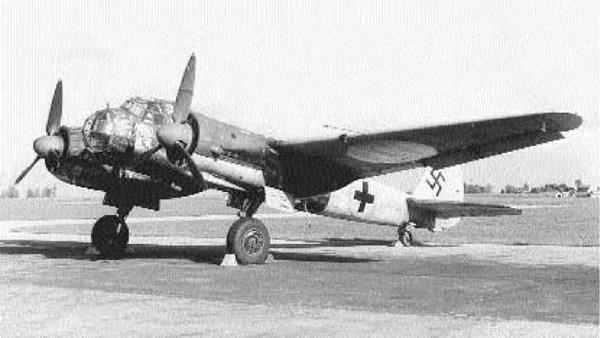
Type: Medium Bomber; Night Fighter; Fighter
Dimensions: wingspan, 65 feet, 7 inches; length, 48 feet, 2 inches; height, 15 feet, 8 inches
Weights: empty, 18,250 pounds; gross, 30,400 pounds
Power plant: 2 x 1,730-horsepower BMW 801G-2 radial engines
Performance: maximum speed, 340 miles per hour; ceiling, 32,800 feet; range, 2,130 miles Armament: 6 x 20mm cannons; 1 x 13mm machine gun; up to 4,409 pounds of bombs Service dates: 1939-1945
|
T |
he Ju 88 was the most numerous and versatile German bomber of World War II. It was grafted to every conceivable purpose, and even served as the lower half of a primitive guide missile!
In 1935 the German Air Ministry announced specifications for a new, twin-engine Schnellbomber (fast bomber). One year later Junkers beat out two other contenders with the Ju 88, a highly streamlined, smoothed-skinned airplane with midmounted wings. A crew of four sat under a large glazed canopy while a bombardier gondola, offset to the left, ran back from the nose. Test results were excellent, but Luftwaffe priorities were skewed to other craft, and production remained slow. By the time World War II erupted in September 1939, only about 50 Ju 88s had reached Luftwaffe units.
In combat the Junkers design was fast, carried a good bomb load, and could absorb great amounts of damage. Moreover, although originally intended as a bomber, it could be adapted to virtually every mis
sion assigned to it: mine-laying, nighttime fighting, reconnaissance, antiship patrols, heavy fighter, ground attack, and dive-bombing. Ju 88s accordingly distinguished themselves in combat from England to Russia, Norway to North Africa. As the Allied ring began closing in on Germany, several dedicated night-fighter versions were developed with radar and heavy armament, such as the Ju 88G. These were among the best such craft deployed, and they accounted for hundreds of Allied bomber kills. The Ju 88S was a stripped-down high-speed bomber that appeared in 1943. It was as fast or faster than most contemporary fighters and therefore only lightly armed. One final version of note was the Mistal, which consisted of a radio-controlled Ju 88 carrying a piggyback Bf 109 or Fw 190 fighter. Once launched, it would be guided to a target like a primitive air-to – ground missile. Ju 88s of every stripe fought with distinction until the very end. Total production of this amazingly versatile machine reached 14,676 units.
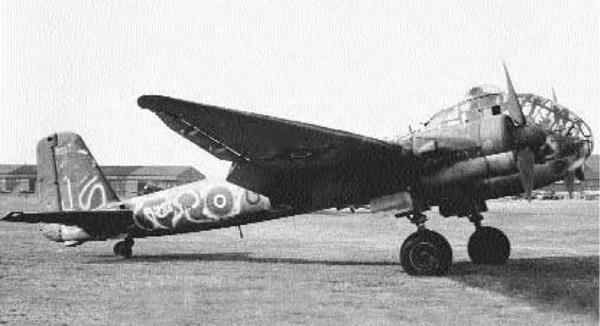
Type: Medium Bomber; Reconnaissance; Torpedo-Bomber
Dimensions: wingspan, 72 feet, 2 inches; length, 49 feet; height, 14 feet, 7 inches
Weights: empty, 21,825 pounds; gross, 31,898 pounds
Power plant: 2 x 1,776-horsepower Junkers Jumo 213A radial engines
Performance: maximum speed, 325 miles per hour; ceiling, 30,665 feet; range, 1,210 miles
Armament: 3 x 7.92mm machine guns; 1 x 20mm cannon; up to 6,614 pounds of bombs
Service dates: 1943-1945
|
A |
ppearing in the wake of the superlative Ju 88, the Ju 188 proved itself an even better aircraft. It excelled as a bomber, torpedo plane, and reconnaissance platform but came too late and in too few numbers to have an impact.
In 1939 the German Air Ministry announced specifications for a new high-speed bomber to replace the Do 17s and He 111s then in service. Junkers proposed a radical new design, the Ju 288, which was plagued with technical obstacles from the onset and never materialized. Meanwhile, the company also worked on the Ju 188 as a private venture in a logical progression from the already successful Ju 88. The new craft bore marked resemblance to its forebear, but it differed in having a new bulbous canopy section and longer, tapering wings. It also sported a power turret and squared-off tail surfaces. The first Ju 188 was test-flown in 1940 with excellent results, although its initial payload was the same as the earlier craft’s. Nonetheless, production
commenced in 1942, and by war’s end 1,076 machines had been delivered.
The Ju 188E was the first production variant and was employed as a radar-equipped torpedo – bomber. It functioned well and was possibly the best of its type during the war. They were followed by the Ju 188F, a high-altitude long-range reconnaissance version that performed useful work in Russia. By
1943 the bugs had been shaken out of the new Jumo 213A engines, and they were fitted to the dedicated bomber variant, the Ju 188A. These proved even faster and more versatile than the already legendary Ju 88s and were very popular with crews. Many were employed as pathfinders during the January
1944 “Little Blitz” against London. The final version, the Ju 188T, was a stripped-down reconnaissance machine that could reach 435 miles per hour at very high altitude. The Ju 188s were excellent machines but appeared too late and in too small numbers to improve Germany’s fortunes.
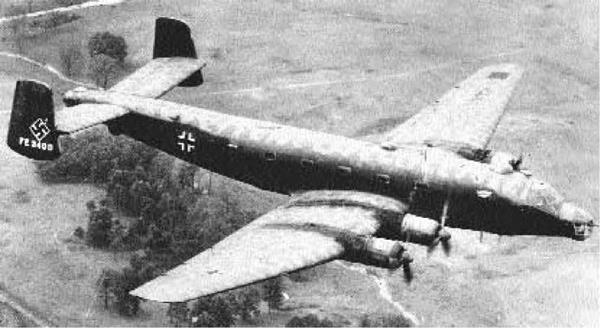
Type: Patrol-Bomber; Reconnaissance; Transport
Dimensions: wingspan, 137 feet, 9 inches; length, 95 feet, 7 inches; height, 22 feet, 4 inches Weights: empty, 72,764 pounds; gross, 101,413 pounds Power plant: 4 x 1,700-horsepower BMW 801D radial engines
Performance: maximum speed, 273 miles per hour; ceiling, 19,685 feet; range, 3,784 miles Armament: 7 x 20mm cannons; up to 6,614 pounds of bombs or missiles Service dates: 1943-1945
|
T |
he huge Ju 290 transport was successfully adapted as a patrol-bomber but served in only limited numbers. One variant, the six-engine Ju 390, was designed to reach New York City and return.
In 1936 Junkers constructed the Ju 89, a practical, four-engine strategic bomber, but Luftwaffe authorities expressed little official interest. The company subsequently developed the aircraft into a civil version, the Ju 90, for the benefit of Deutsche Lufthansa. Eight were built and functioned as the pride of Lufthansa until 1939, when all were impressed into military service. At that time, the Luftwaffe desired a new bomber as an eventual replacement for the Focke-Wulf Fw 200 Kondor, and Junkers complied with the Ju 290. This was essentially a Ju 90 with redesigned wings and better engines. Flight tests were encouraging, so the aircraft entered production in
1942. A total of 66 of the lumbering giants were built.
The Ju 290s were variously employed in maritime patrol and as military transports. They were
excellent machines and well-liked by crews but were never available in sufficient number to affect much. From their bases in France they would arc out over the Atlantic, relaying convoy locations to a dwindling number of U-boats. Others found work during the siege of Stalingrad, ferrying supplies and evacuating wounded, with several being lost. Subsequent models of the Ju 290 bristled with increasingly heavier armament, radar, and antishipping missiles, but they failed to surmount Allied control of the air. Nonetheless, in the fall of 1944 a pair of Ju 290s staged an impressive round-trip flight, 5,000 miles, to Manchuria and back.
In 1940 the Luftwaffe called for creation of an even bigger machine, the so-called Amerika Bomber, in the event of war with the United States. Junkers then conceived the Ju 390, which had a lengthened fuselage, wings, and six engines. Only two of these capable craft were built, and they did not proceed beyond a few test flights.
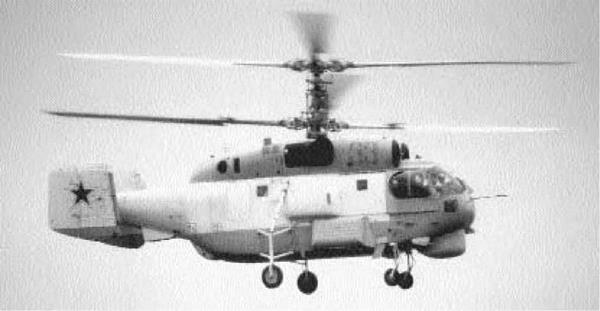
Type: Antisubmarine; Transport
Dimensions: rotorspan, 52 feet, 2 inches; length, 37 feet, 1 inch; height, 17 feet, 9 inches
Weights: empty, 13,338 pounds; gross, 27,778 pounds
Power plant: 2 x 2,205-horsepower Klimov TV3-117V turboshaft engines
Performance: maximum speed, 155 miles per hour; ceiling, 16,405 feet; range, 497 miles
Armament: torpedoes or depth charges
Service dates: 1981-
|
T |
he tubby Ka 27 (NATO code name HELIX) is the latest member of a long-serving and successful series of Russian naval helicopters. In addition to antisubmarine warfare (ASW) versions, other models can perform assault and radar picket work.
In 1956 the Soviet navy issued requirements for a new and capable helicopter for ASW purposes. Such a machine would also have to be compact, owning to the cramped storage facilities aboard many Russian naval vessels. Nikolai Kamov’s design bureau confronted the problem with great imagination and engineering skill by producing the first Ka 25 (NATO code name HORMONE) in 1960. This was a rotund, twin-engine helicopter utilizing what became the company trademark: counter-rotating coaxial rotors. This unique system offered many advantages over conventional layouts, with the most obvious being deletion of the long tailboom and dangerous tailrotor. Commencing in 1966, the Ka 25 became the standard Soviet ASW platform at sea, easily recognized by various sonar bugles and protuberances. More than
600 were built, and many still fly in former Soviet client state navies.
In 1981 Kamov was succeeded by Sergei Mikheyev, who continued the company tradition by designing the newer Ka 27. As before, the new machine was coaxial-powered, which allowed a stubby, compact design, although in this case somewhat bigger than the previous machine. The Ka 27 featured a crew of five, twin canted fins, and two engines with twice the power. Moreover, it is the first Kamov design capable of all-weather and nighttime ASW missions. At least 100 have been built and currently serve with the Russian navy.
In 1980 Kamov subsequently built upon its earlier success by designing two additional models. The Ka 39 is a tactical assault helicopter for Russian naval infantry, with an enlarged cabin and heavy armament in the form of machine guns and rocket pods. The similar Ka 31 is designed for radar picket work, with a large E-801 Oko radar bulge under the belly. Both were procured in small numbers before the collapse of the Soviet Union in 1991.
|
Dimensions: rotorspan, 45 feet; length, 52 feet, 5 inches; height, 17 feet, 8 inches Weights: gross, 16,534 pounds
Power plant: 2 x Klimov TV3-11VK turboshaft engines
Performance: maximum speed, 217 miles per hour; ceiling, 13,125 feet; range, 155 miles Armament: 1 x 30mm cannon; 16 x AT-9 Vikhr missiles; various gunpods Service dates: 1992-
|
T |
he futuristic Ka 50, nicknamed “Black Shark” by the Russians, is the world’s first single-seat attack helicopter. It retains many trademark features of the Kamov design bureau and is currently awaiting export orders.
In the 1970s Western mania for large and sophisticated attack helicopters like the Hughes AH-64 Apache convinced Soviet authorities that they should emulate such tactical thinking. In 1977 Kamov design bureau chief Sergei Mikheyev advanced a new machine based upon proven company concepts. The Ka 50 is the world’s first single-seat attack helicopter design, so chosen to enhance its survivability over larger two-seat machines. It is also unique in employing the coaxial rotor configuration that is a Kamov trademark. The reason behind this adaptation is that single rotors were perceived as too vulnerable to damage in low-level ground-attack work. The fuselage is attenuated, heavily armored, and ends in a long, blunt snout. It is also partially made from lightweight composite materials that add
greatly to overall strength. Moreover, to assist the pilot, the cockpit is completely computerized and employs the Kamov autoland, autohover, and auto-formation-flying equipment pioneered in naval helicopters. Finally, this craft is the first helicopter in the world to boast an ejection system for the pilot. The sequence begins when explosive bolts shed the rotor blades, and then a rocket pack drags the helpless operator out of his cockpit!
To fulfill its mission as an antitank attack helicopter, the Ka 50 is extremely well armed. It sports no less than 16 Vikhr antitank missiles, which are supersonic and capable of penetrating reactive armor up to a thickness of 35 inches. A 30mm high velocity cannon is also fitted to the starboard side of the fuselage, and the choice of either explosive or armor-piercing ammunition can be made in flight. In sum, the Ka 50 is a formidable adversary and goes by the NATO designation HOKUM. The precise number of Ka 50s in service since the collapse of the Soviet Union has not been determined.
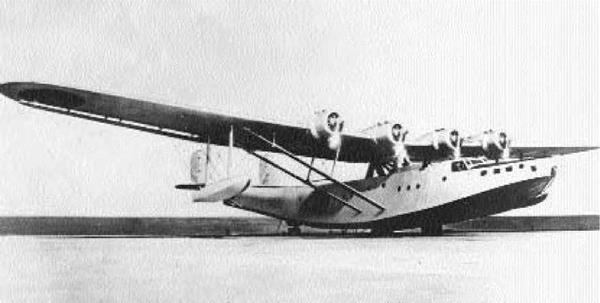
Type: Reconnaissance; Transport
Dimensions: wingspan, 131 feet, 2 inches; length, 84 feet, 1 inch; height, 20 feet, 6 inches
Weights: empty, 27,293 pounds; gross, 50,706 pounds
Power plant: 4 x 1,300-horsepower Mitsubishi Kinsei 53 radial engines
Performance: maximum speed, 239 miles per hour; ceiling, 31,365 feet; range, 4,210 miles
Armament: 4 x 7.7mm machine guns; 1 x 20mm cannon; up to 2,205 pounds of torpedoes
Service dates: 1938-1945
|
T |
he graceful H6K was among the best flying boats during the early stages of the Pacific war. It boasted greater range and endurance than its American and British counterparts.
The Japanese navy first gained experience with flying boats with the assistance of a team of engineers from the British Short firm in 1930. Within five years Japan had accumulated sufficient experience to manufacture similar craft on its own. Such was the case when the navy issued a 9-Shi (1934) specification to Kawanishi for a large flying boat of unprecedented range and endurance. Fortuitously, the Japanese had recently purchased an example of the Consolidated P2Y Ranger from the United States, and Kawanishi design teams under Yoshio Hashiguchi and Shizuo Kikuhara set about adapting it for their own purposes. The prototype H6K first flew in 1936 as a large four-engine aircraft with particularly pleasing lines. The streamlined two-step hull mounted a parasol wing on struts and pylons, and two stabilizing floats were placed outboard of
midspan. The first H6Ks rolled off the assembly lines in 1938 and, by virtue of their excellent air and water handling, were among the best flying boats in the world. When the Pacific war commenced in December 1941, the Imperial Japanese Navy possessed 64 of these impressive giants, soon to be known to the Allies as Mavis.
The H6K was heavily employed throughout extensive reaches of the Southwest Pacific. In addition to reconnaissance work, they carried a variety of bombs or torpedoes, and on several occasions they raided Rabaul and northern Australia. However, a major weak point was the lack of self-sealing fuel tanks, which rendered them very vulnerable to enemy fighters. By 1943, as Allied defenses improved, losses had grown untenable, and the Mavis became restricted to nighttime flying and transportation work. They were well suited to this role, having been operated by Japan Air Lines in this manner for several months prior to hostilities. A total of 217 H6Ks were built.
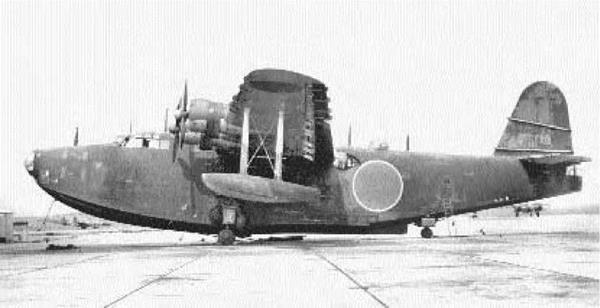
Type: Reconnaissance; Transport
Dimensions: wingspan, 124 feet, 8 inches; length, 92 feet, 4 inches; height, 30 feet Weights: empty, 40,521 pounds; gross, 71,650 pounds Power plant: 4 x 1,530-horsepower Mitsubishi MK4B Kasei radial engines Performance: maximum speed, 290 miles per hour; ceiling, 28,740 feet; range, 4,460 miles Armament: 5 x 20mm cannons; 4 x 7.7mm machine guns; up to 4,408 pounds of bombs Service dates: 1942-1945
|
T |
he mighty H8K was the best all-around flying boat of World War II, superior in many respects to all other British, American, and German designs. Fast and heavily armed, it was difficult to shoot down and treated respectfully by enemy fighters.
By 1938 Japanese naval planners realized that it would take three years to produce a more modern replacement for the H6K flying boat. They then issued a 14-Shi specification calling for a craft with performance superior to that of the contemporary Short Sunderland. Accordingly, a design team headed by Shizuo Kikuhara set about conceiving what evolved into the world’s best flying boat. The prototype flew in 1940 as a high-wing, all-metal monoplane with a rather narrow hull and extremely clean lines. Unfortunately, this version proved unstable during water taxiing tests and prone to porpoising uncontrollably. Consequently, a revised model was built featuring a deepened two-step hull and modified flaps, both of which cured the problem. The new craft, designated the H8K 1, was also heavily
armed, mounting no less than five 20mm cannons and four 7.7mm machine guns. Moreover, unlike traditional Japanese warplanes, it also featured selfsealing fuel tanks and considerable armor plating for the crew. During World War II this massive craft came to be known to the Allies as Emily.
The H8K was a formidable war machine. With a range over 4,000 miles, it was fast, maneuverable, and could cruise 27 hours without refueling. Wellarmed and armored, it was also extremely difficult to shoot down and had to be approached gingerly. The combat debut of the H8K occurred in March 1942 when a pair of Emilys flew several hundred miles from French Frigate Shoals to Pearl Harbor, only to discover the target was obscured by cloud cover. Thereafter, the big flying boat was encountered throughout the Pacific while performing maritime reconnaissance. In 1943 a transport version, the H8K2 Seika (Clear Sky), was developed that could carry 64 fully armed troops. A total of 175 were constructed.
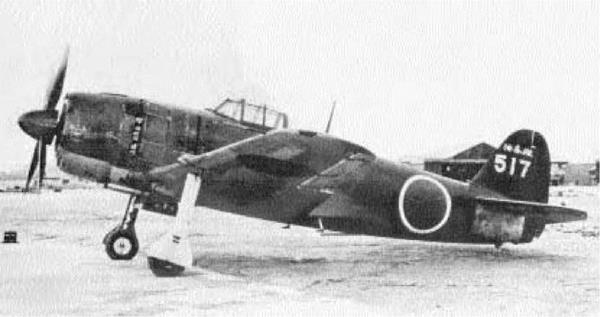
Type: Fighter
Dimensions: wingspan, 39 feet, 4 inches; length, 30 feet, 8 inches; height, 13 feet Weights: empty, 5,858 pounds; gross, 8,818 pounds
Power plant: 1 x 1,990-horsepower Nakajima NK9H Homare radial engine Performance: maximum speed, 369 miles per hour; ceiling, 35,300 feet; range, 1,488 miles Armament: 4 x 20mm cannon Service dates: 1944-1945
|
T |
he Shiden Kai was one of the best all-around fighters deployed by Japan in World War II. Its success is even more surprising considering that it evolved from a floatplane.
In 1940 the Imperial Japanese Navy sought possession of a capable floatplane fighter to be used in conjunction with the tactic of island hopping. Kawanishi responded with the N1K1 Kyofu (Mighty Wind), a streamlined and powerful aircraft. By 1943, however, Japan was on the defensive and needed newer, land – based fighters. A design team subsequently overhauled the Kyofu by eliminating the floats, and thus the N1K1-J was born. This was a heavily armed, midwing fighter of great strength and maneuverability. It carried no less than four 20mm cannons and two 7.7mm machine guns, in addition to armor for the pilot. Called the Shiden (Violet Lightning), it proved a formidable fighter and very much equal to Grumman F6F Hellcats and Vought F4U Corsairs. And unlike most Japanese fighters, it was rugged and difficult to shoot down. However, Shidens suffered from unreliable Homare radial engines and problems associated
with the long, telescopic landing gear inherent in midwing configurations. Kawanishi nonetheless produced 1,001 of these excellent machines, which received the Allied code name George 11.
In the fall of 1943, the Kawanishi design teams took another look at their promising fighter in an attempt to simplify and improve it. The biggest changes involved adapting a low-wing construction, along with revised tail surfaces and a cleaned-up cowl. Shorter, more conventional landing gear were also fitted. The result was the N1K2-J Shiden Kai (Modified Violet Lightning). It boasted higher performance using the same engine and one-third fewer parts than the original design. This craft, known to the Allies as George 21, was an even better dog – fighter than the legendary Zero. On February 6, 1945, a single N1K2 flown by the noted ace Kaneyoshi Muto single-handedly engaged 12 Grumman F6F Hellcats, shooting down four and driving the remainder off! Unfortunately for Japan, this excellent fighter was never available in sufficient quantity to turn the tide of events. Only 428 were built.
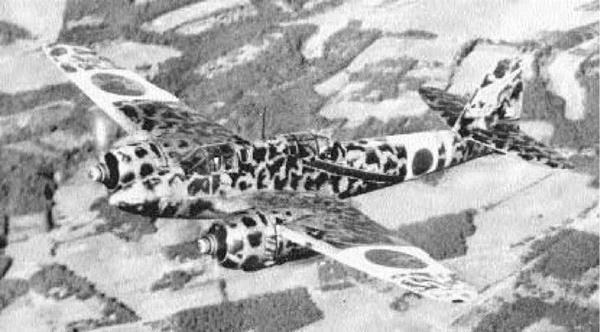
Type: Fighter; Night Fighter
Dimensions: wingspan, 49 feet, 4 inches; length, 36 feet, 1 inch; height, 12 feet, 1 inch
Weights: empty, 8,818 pounds; gross, 12,125 pounds
Power plant: 2 x 1,080-horsepower Mitsubishi Ha-102 radial engines
Performance: maximum speed, 339 miles per hour; ceiling, 32,810 feet; range, 1,243 miles
Armament: 1 x 37mm cannon; 2 x 20mm cannon, 1 x 7.7mm machine gun
Service dates: 1942-1945
|
T |
he Ki 45 was Japan’s first twin-engine fighter and its most successful night fighter. It also served capably in a variety of missions, including ground attack, antishipping, and kamikaze.
By 1937 the notion of long-range strategic fighters, capable of escorting bomber fleets to targets and back, was becoming prevalent. Germany began successfully experimenting with its Messer – schmitt Bf 110, which prompted the Imperial Japanese Army to adopt similar craft. That year it invited several companies into a competition, and Kawasaki, after many trials and prototypes, originated the Ki 45 Toryu (Dragon Slayer). This was a handsome, low-wing design with a pointed nose and a long, tandem cabin housing pilot and gunner. Initial flights revealed that the craft was underpowered, so a succession of better engines ensued until the Nakajima Ha-25 was utilized. Other problems centered around the landing gear, which were weak and hand-cranked in flight. With better motors and powered undercarriage, the Ki 45 showed promise,
so in 1941 it entered production. A total of 1,701 were ultimately built, and they received the code name Nick during World War II.
The first Ki 45s were deployed in Southeast Asia and, despite exceptional maneuverability for their size, were at a disadvantage fighting single-engine opponents. Given their speed and heavy armament, however, they proved ideal for ground attacks and antishipping strikes. Moreover, the Ki 45 was also an effective bomber interceptor and played havoc with American B-24 formations throughout Burma and Indochina. When the B-24s switched to night attacks, the Ki 45 was converted into a night fighter by mounting heavy cannons on top of the fuselage in slanted fashion. Considerable success was achieved, which gave rise to the Ki 45 KAIc, a dedicated night-fighter version, in 1944. These machines also performed useful work against high-flying B-29s over Japan toward the end of the war. More ominously, on May 27, 1944, it fell upon four Nicks to perform the first army kamikaze attacks against American warships off Biak.
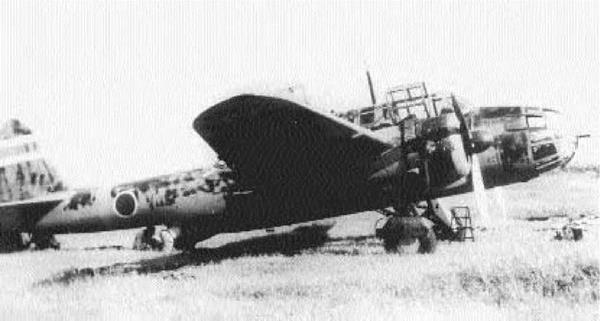
Type: Light Bomber
Dimensions: wingspan, 57 feet, 3 inches; length, 41 feet, 10 inches; height, 12 feet, 5 inches
Weights: empty, 10,031 pounds; gross, 14,881 pounds
Power plant: 2 x 1,150-horsepower Nakajima Ha-115 radial engines
Performance: maximum speed, 314 miles per hour; ceiling, 33,135 feet; range, 1,491 miles
Armament: 3 x 7.7mm machine guns; up to 1,764 pounds of bombs
Service dates: 1940-1945
|
A |
t the beginning of World War II, the Ki 48 was Japan’s most important light bomber. Slow and underarmed, it was never much of a threat against improving Allied defenses.
By 1938 Japanese forces operating in China began encountering numbers of Soviet-supplied Tupolev SB 2 light bombers. These proved so fast that Japan’s most modern interceptor, the Nakajima Ki 27, could scarcely intercept them. Naturally, the Imperial Japanese Army sought possession of a light bombardment aircraft with similar capabilities. A Kawasaki design team under Takeo Doi then commenced work on a prototype that emerged in 1939. The new Ki 48 was a modern-looking, midwing bomber with a crew of four and an internal bomb bay. Variable-pitch propellers were also fitted to the two Nakajima Ha-25 radial engines for improved performance. The new craft flew fast and handled very well, so it entered production in 1940. That fall the first units equipped with Ki 48s arrived in northern China and commenced combat operations. As
expected, the new bomber simply outflew weak Chinese defenses and established a reputation for reliability and ease of maintenance. By the advent of the Pacific war in December 1941, the Ki 48 was the most numerous light bomber in the Japanese arsenal. It received the Allied designation Lilly.
During the opening phases of war, Ki 48s performed useful work against British forces in Southeast Asia and the U. S. installations in the Philippines. This, however, was accomplished largely in the presence of Japanese air superiority. Advancing next upon the Dutch East Indies and New Guinea, Ki 48s began taking heavy losses over Australia as defenses consolidated and resistance stiffened. Kawasaki then introduced the Ki 48-II, which featured bigger engines, twice the bomb load, and slightly heavier armament. These, too, wilted in the face of newer Allied fighters, and by 1943 the Lilly was restricted to night bombing. By 1944 all were declared obsolete, and many ended their days as kamikazes. Production amounted to 1,977 machines.
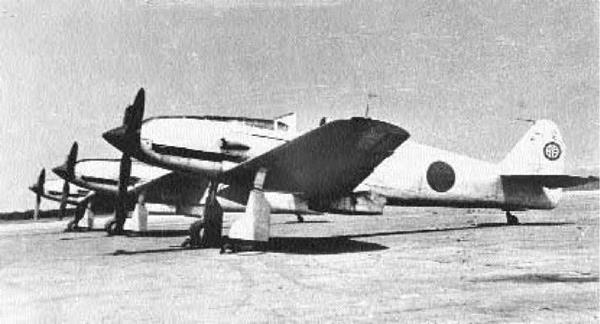
Type: Fighter
Dimensions: wingspan, 39 feet, 4 inches; length, 29 feet, 4 inches; height, 12 feet, 1 inch Weights: empty, 5,798 pounds; gross, 7,650 pounds
Power plant: 1 x 1,175-horsepower Kawasaki Ha-40 liquid-cooled in-line engine Performance: maximum speed, 348 miles per hour; ceiling, 32,810 feet; range, 1,181 miles Armament: 2 x 12.7mm machine guns; 2 x 20mm cannon Service dates: 1943-1945
|
T |
he streamlined Hien was a useful aircraft beset by troublesome power plants. Once outfitted with a new radial engine, however, it became Japan’s finest fighter of World War II.
In 1937 Kawasaki obtained rights to manufacture the superb German Daimler-Benz DB 601A inline engine. Three years later the Japanese army requested that Kawasaki design a fighter around this power plant. A team under Takeo Doi then constructed a prototype that initially flew in December 1941. In contrast with other radial-powered Japanese fighters, the Ki 61 possessed rakish lines reminiscent of the Messerschmitt Bf 109F. It was also heavily armed with four machine guns and possessed pilot armor in contrast to prevailing design philosophies. Moreover, mock combat trials between the Bf 109 and captured examples of the Curtiss P-40 revealed the Ki 61 superior to either warplane. The Imperial Japanese Army was then in great need to replace its aging Ki 43 Hayabusa fighters, so it authorized the new craft into production as the Hien (Swallow). Al
lied forces gave it the code name Tony; production came to 2,654 machines
The Ki 61 debuted at New Guinea in the spring of 1943 and was relatively successful in combat. It was as fast as many Allied fighters and even more maneuverable. However, recurrent problems with the Ha-40 engine were never resolved. In 1943 an improved version, the Ki 61-II, mounted a bigger engine, but it suffered from even worse maintenance problems than earlier craft. Nonetheless, by 1945 the Tony was one of few Japanese aircraft able to attack American B-29 bombers at high altitude. When air raids finally destroyed the last stock of Ha-40 engines, Kawasaki was ordered to fit existing airframes with the Mitsubishi 112-II radial engine. This was engineered with considerable finesse, and the new fighter, christened the Ki 100, was the best Japanese fighter of the war. It easily outflew the F6F Hellcats and P-51 Mustangs encountered over Japan, but only 272 were built before the war ended.
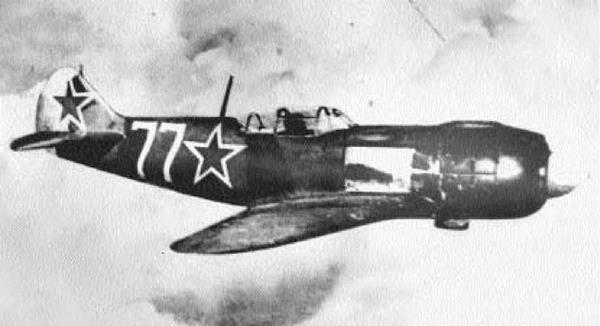
Type: Fighter
Dimensions: wingspan, 32 feet, 2 inches; length, 28 feet, 2 inches; height, 9 feet, 3 inches
Weights: empty, 5,816 pounds; gross, 7,496 pounds
Power plant: 1 x 1,859-horsepower Shvetsov M-82FN radial engine
Performance: maximum speed, 413 miles per hour; ceiling, 35,435 feet; range, 395 miles
Armament: 3 x 20mm cannons; up to 441 pounds of bombs
Service dates: 1942-1945
|
T |
he La 7 was among the best fighters produced during World War II. It was a superior dogfighter to both the Bf 109 and Fw 190 and the chosen mount of leading Soviet aces.
In the fall of 1941, as the German blitzkrieg rolled toward Moscow, the Soviet government began frantically scrambling to acquire more efficient weapons. Semyon Lavochkin, who had divested himself from his earlier partnership, began developing the inadequate LaGG 3 into a first-class fighter. He started by taking a basic LaGG frame, fitting it with a powerful M-82 radial engine, and the effects were startling. With additional refinements like a cut-down canopy and redesigned cowl, the new La 5 proved faster than the fabled Bf 109G in speed and maneuverability. These machines were first committed during the horrific Battle of Stalingrad in 1942 and acquitted themselves well. The following year, the La 5FN, with a fuel-injected engine, arrived during the Battle at Kursk, again with good results. Compared to the stopgap LaGG 3, Lavochkin’s new
fighters were fast, responsive, and highly agile at low altitudes. In the hands of capable pilots like Ivan Kozhedub, the leading Allied ace with 62 kills, Russia slowly wrested air superiority away from the Germans.
Lavochkin’s final wartime variant was the La 7. This was basically an La 5FN fitted with a more powerful engine and additional aeronautical refinements. These included metal wing spars (earlier craft being made entirely of wood) for greater strength and lighter weight. The armament was also increased to three 20mm cannons that spat out seven pounds of lead per second. In an attempt to shed even more weight, the fuel capacity was cut in half, reducing the fighter’s operational radius to about an hour. However, because Soviet fighters were usually deployed right on the front lines, this was not viewed as detrimental. Lavochkin fighter craft were major contributors to the ultimate Soviet victory, and their designer received the prestigious Stalin Prize. Production totaled 21,975 of all models.
|
Dimensions: wingspan, 32 feet, 1 inch; length, 29 feet, 1 inch; height, 8 feet, 10 inches Weights: empty, 5,776 pounds; gross, 7,275 pounds Power plant: 1 x 1,240-horsepower M-105PF liquid-cooled in-line engine Performance: maximum speed, 348 miles per hour; ceiling, 29,350 feet; range, 404 miles Armament: 2 x 7.62mm machine guns; 2 x 12.7mm machine guns; 1 x 20mm cannon Service dates: 1940-1945
|
T |
he much-derided LaGG 3 was the most numerous Soviet fighter during the early days of the Great Patriotic War (the Soviet name for World War II). A robust design, it nonetheless exhibited marginal performance and suffered great losses.
In 1938 the Soviet government announced competition for a new single-seat fighter with optimal performance at medium to low altitudes. A design bureau headed by Semyon A. Lavochkin, assisted by engineers V. Gorbunov and M. Gudlov (hence the designation LaGG), designed and flew the prototype I 22 in 1939. It was a streamlined and conventional – appearing aircraft for its class but also unique in reverting to wooden construction. In fact, only the cowling and movable control surfaces employed metal. The wood itself was impregnated with plastic for added strength, but this added greatly to overall weight. The I 22 demonstrated serious performance deficiencies during flight-testing, but as Stalin demanded great amounts of fighters, Lavochkin was ordered to salvage his design rather than start over.
The I 22 entered production as the LaGG 1 in 1940 and, in a play upon the designer’s initials, pilots nicknamed it the “Guaranteed Wooden Coffin.” Further modifications eventually yielded the LaGG 3 in 1941, which was lighter and fitted with wing slats. These modifications cured the craft’s most vicious characteristics, but climbing performance remained poor. By 1942, 6,258 LaGG 3s had been constructed.
The LaGG 3 was among the most numerous Soviet fighters when the Great Patriotic War erupted in June 1941. For many months they bore the brunt of Germany’s aerial onslaught and, being inferior to the Messerschmitt Bf 109, suffered heavily. Many more craft would have been lost had it not been for the LaGG’s amazing ability to absorb damage and keep flying. By 1943 most had been superceded by the radial-powered and far superior La 5. Many LaGGs were employed for the rest of the war as low – level escorts for the Il 2 ground-attack craft. It is best remembered as a sacrificial aircraft marking time until the arrival of better designs.











